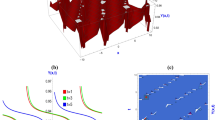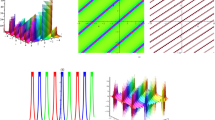Abstract
Under study in this paper is a generalized higher-order nonlinear Schrödinger (GHNLS) equation with the third-order dispersion (TOD), self-steeping (SS) and stimulated Raman scattering effects , which describes the propagation of ultrashort pulses in optical fibers. Via the phase plane analysis, both the homoclinic and heteroclinic orbits are found in the two-dimensional plane autonomous system reduced from the GHNLS equation, which proves the existence of bright and dark soliton solutions from the viewpoint of nonlinear dynamics. Furthermore, through the method of binary Bell polynomials and auxiliary function, the explicit bright and dark soliton solutions under certain conditions are obtained. Particular analysis is made to study the effects of the higher-order on the double-hump bright and double-hole dark solitons. The results show that the self-phase modulation and SS parameters determine the interval between two humps for the double-hump bright soliton, while the one for the double-hole dark soliton is related with the TOD and SS effects. Moreover, numerical simulations show that the double-hump bright soliton and the double-hole dark soliton are more stable when the amplitude or depth is comparably small.







Similar content being viewed by others
References
Watanabe, S.: Optical signal processing using nonlinear fibers. J. Opt. Fiber Commun. Rep. 3, 1–24 (2006)
Willner, A.E., Khaleghi, S., Chitgarha, M.R., Yilmaz, O.F.: All-optical signal processing. J. Light. Tech. 32, 660–680 (2014)
Doran, N.J., Blow, K.J.: Solitons in optical communications. IEEE J. Quan. Electron. 19, 1883–1888 (1983)
Hasegawa, A., Tappert, F.: Transmission of stationary nonlinear optical pulses in dispersive dielectric fibers. I. Anomalous dispersion. Appl. Phys. Lett. 23, 142 (1973)
Hasegawa, A., Tappert, F.: Transmission of stationary nonlinear optical pulses in dispersive dielectric fibers. II. Normal dispersion. Appl. Phys. Lett. 23, 171 (1973)
Mollenauer, L.F., Stolen, R.H., Gordon, J.P.: Experimental observation of picosecond pulse narrowing and solitons in optical fibers. Phys. Rev. Lett. 45, 1095–1098 (1980)
Emplit, P., Hamaide, J.P., Reynaud, F., Froehly, C., Barthelemy, A.: Picosecond steps and dark pulses through nonlinear single mode fibers. Opt. Commun. 62, 374–379 (1987)
Agrawal, G.P.: Nonlinear Fiber Optics. Academic, California (2002)
Mitschke, F.M., Mollenauer, L.F.: Random walk of coherently amplified solitons in optical fiber transmission. Opt. Lett. 11, 665–667 (1986)
Gordon, J.P.: Theory of the soliton self-frequency shift. Opt. Lett. 11, 662–664 (1986)
Porsezian, K., Nakkeeran, K.: Optical solitons in presence of Kerr dispersion and self-frequency shift. Phys. Rev. Lett. 76, 3955–3958 (1996)
Kivshar, Yu S., Agrawal, G.P.: Optical Solitons: From Fibers to Photonic Crystals. Academic, San Diego (2003)
Porsezian, K.: Soliton models in resonant and nonresonant optical fibers. Pramāna 57, 1003–1039 (2001)
Mihalache, D., Torner, L., Moldoveanu, F., Panoiu, N.C., Truta, N.: Inverse-scattering approach to femtosecond solitons in monomode optical fibers. Phys. Rev. E 48, 4699–4709 (1993)
Gedalin, M., Scott, T., Band, Y.: Optical solitary waves in the higher order nonlinear Schrödinger equation. Phys. Rev. Lett. 78, 448–451 (1997)
Mihalache, D., Truta, N., Crasovan, L.C.: Painlevé analysis and bright solitary waves of the higher-order nonlinear Schrödinger equation containing third-order dispersion and self-steepening term. Phys. Rev. E 56, 1064–1070 (1997)
Nijhof, J.H.B., Roelofs, G.H.M.: Prolongation structures of a higher-order nonlinear Schrödinger equation. J. Phys. A 25, 2403–2416 (1992)
Hirota, R.: Exact envelope-soliton solutions of a nonlinear wave equation. J. Math. Phys. 14, 805–809 (1973)
Sasa, N., Satsuma, J.: New-type of soliton solutions for a higher-order nonlinear Schrödinger equation. J. Phys. Soc. Jpn. 60, 409–417 (1991)
Xu, Z.Y., Li, L., Li, Z.H., Zhou, G.S.: Soliton interaction under the influence of higher-order effects. Opt. Commun. 210, 375–384 (2002)
Gilson, C., Hietarinta, J., Nimmo, J., Ohta, Y.: Sasa-Satsuma higher-order nonlinear Schrödinger equation and its bilinearization and multisoliton solutions. Phys. Rev. E 68, 016614 (2008)
Palacios, S.L., Guinea, A., Fernández, J.M., Crespo, R.D.: Dark solitary waves in the nonlinear Schrödinger equation with third order dispersion, self-steepening, and self-frequency shift. Phys. Rev. E 60, R45–R47 (1999)
Jiang, Y., Tian, B.: Dark and dark-like-bright solitons for a higher-order nonlinear Schrödinger equation in optical fibers. EPL 102, 10010 (2013)
Jiang, Y., Tian, B., Li, M., Wang, P.: Bright hump solitons for the higher-order nonlinear Schröinger equation in optical fibers. Nonlinear Dyn. 74, 1053–1063 (2013)
Xu, J., Fan, E.: The unified transform method for the Sasa-Satsuma equation on the half-line. Proc. R. Soc. A 469, 20130068 (2013)
Xu, T., Wang, D.H., Li, M., Liang, H.: Soliton and breather solutions of the Sasa-Satsuma equation via the Darboux transformation. Phys. Scr. 89, 075207 (2014)
Zhao, L.C., Li, S.C., Ling, L.M.: Rational W-shaped solitons on a continuous-wave background in the Sasa-Satsuma equation. Phys. Rev. E 89, 023210 (2014)
Alligood, K.T., Sauer, T.D., Yorke, J.A.: An Introduction to Dynamical Systems. Springer, Berlin (2000)
Ablowitz, M.A., Clarkson, P.A.: Solitons Nonlinear Evolution Equations and Inverse Scattering. Cambridge University, Cambridge (1992)
Guo, R., Hao, H.Q.: Breathers and localized solitons for the Hirota–Maxwell–Bloch system on constant backgrounds in erbium doped fibers. Ann. Phys. 344, 10–16 (2014)
Guo, R., Hao, H.Q., Zhang, L.L.: Dynamic behaviors of the breather solutions for the AB system in fluid mechanics. Nonlinear Dyn. 74, 701–709 (2013)
Liu, S.D., Liu, S.K.: Soliton Wave and Turbulence (Chinese version). Shanghai Scientific and Technological Education, Shanghai (1994)
Infeld, E., Rowlands, G.: Nolinear Waves Solitons and Chaos. Cambridge University, Cambridge (2000)
Akhmediev, N., Ankiewicz, A.: Multi-soliton complexes. Chaos 10, 600–612 (2000)
Hirota, R.: The Direct Method in Soliton Theory. Cambridge University, Cambridge (2004)
Lambert, F., Springael, J.: Soliton equations and simple combinatorics. Acta Appl. Math. 102, 147–178 (2008)
Gilson, C., Lambert, F., Nimmo, J., Willox, R.: On the combinatorics of the Hirota D-operators. Proc. R. Soc. Lond. A 452, 223–234 (1996)
Bao, W., Jin, S., Markowich, P.A.: On time-splitting spectral approximations for the Schrödinger equation in the semiclassical regime. J. Comput. Phys. 175, 487–524 (2002)
Bao, W., Jin, S., Markowich, P.A.: Numerical study of time-splitting spectral discretizations of nonlinear Schrödinger equations in the semiclassical regimes. SIAM J. Sci. Comput. 25, 27–64 (2003)
Sanders, B.F., Katopodes, N.D., Boyd, J.P.: Spectral modeling of nonlinear dispersive waves. J. Hydraul. Eng. 124, 2–12 (1998)
Acknowledgments
This work has been supported by the Fundamental Research Funds of the Central Universities (Project Nos. 2014QN30 and 2014ZZD10), by the National Natural Science Foundations of China (Grant Nos. 11426105, 11371371,-11305060, 11271126 and 11247267) and by the Postdoctoral Science Foundation of China (2013M540907).
Author information
Authors and Affiliations
Corresponding authors
Appendix
Appendix
Some necessary notations on the Bell polynomials can be seen as follows:
Let \(f=f(x_1,\ldots ,x_n)\) be a \(C^{\infty }\) multi-variable function then, the multi-dimensional Bell polynomials can be defined as below [36, 37]:
where \(f_{r_1x_1,\ldots ,r_lx_l}=\partial ^{r_1}_{x_1}\cdots \partial ^{r_l}_{x_l}\,f\, (r_k=0,\ldots ,n_k,k=1,\ldots ,l)\) and \(Y_{n_1x_1,\ldots ,n_lx_l}(f)\) denotes the multi-variable polynomial with respect to \(f_{r_1x_1,\ldots ,r_lx_l}\). In particular, for \(f=f(x,t)\), the associated two-dimensional Bell polynomials are
In order to differ the odd- and even-order derivatives of \(f_{r_1x_1,\ldots ,r_lx_l}\), the multi-dimensional binary Bell polynomial (\({\fancyscript{Y}}\)-polynomial) is introduced as follows [37]:
Then, Eqs. (38), (39) and (40) can be rewritten in the form of binary Bell polynomials as
Note that the \({\fancyscript{Y}}\)-polynomial and the Hirota expression \(D^{n_1}_{x_1}\cdots D^{n_l}_{x_l}F\cdot G\) can be linked by the identity [37]
where the Hirota bilinear operators are defined by [35]
In particular, when \(F=G\), Eq. (41) becomes
where the \(P\)-polynomials take the even part partitional structure
Therefore, a nonlinear equation can be transformed into the corresponding bilinear equation via Expressions (41), (43) and (44), once this nonlinear equation is expressible as a linear combination of \({\fancyscript{Y}}\)-polynomials.
Rights and permissions
About this article
Cite this article
Li, M., Xu, T. & Wang, L. Dynamical behaviors and soliton solutions of a generalized higher-order nonlinear Schrödinger equation in optical fibers. Nonlinear Dyn 80, 1451–1461 (2015). https://doi.org/10.1007/s11071-015-1954-z
Received:
Accepted:
Published:
Issue Date:
DOI: https://doi.org/10.1007/s11071-015-1954-z




